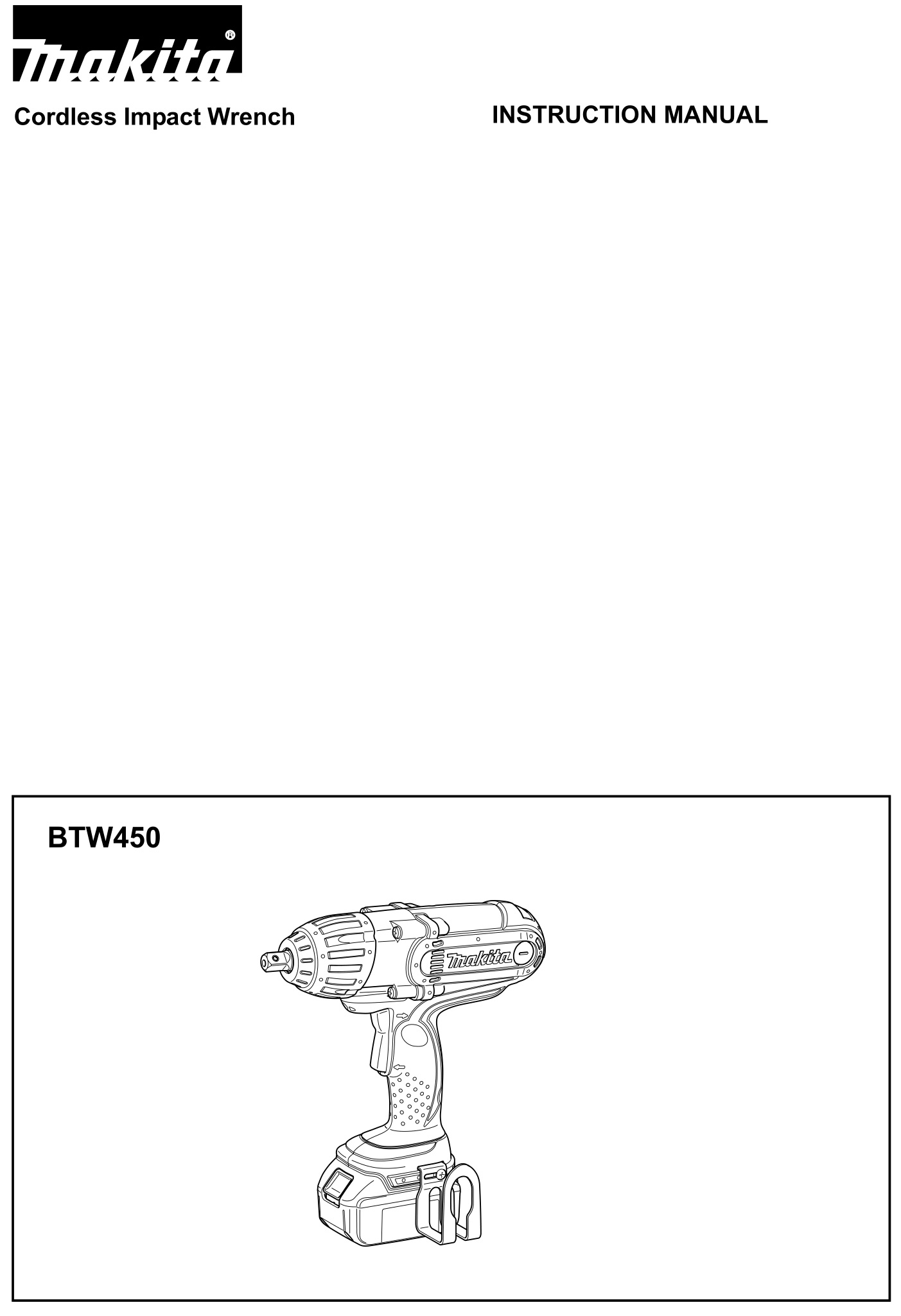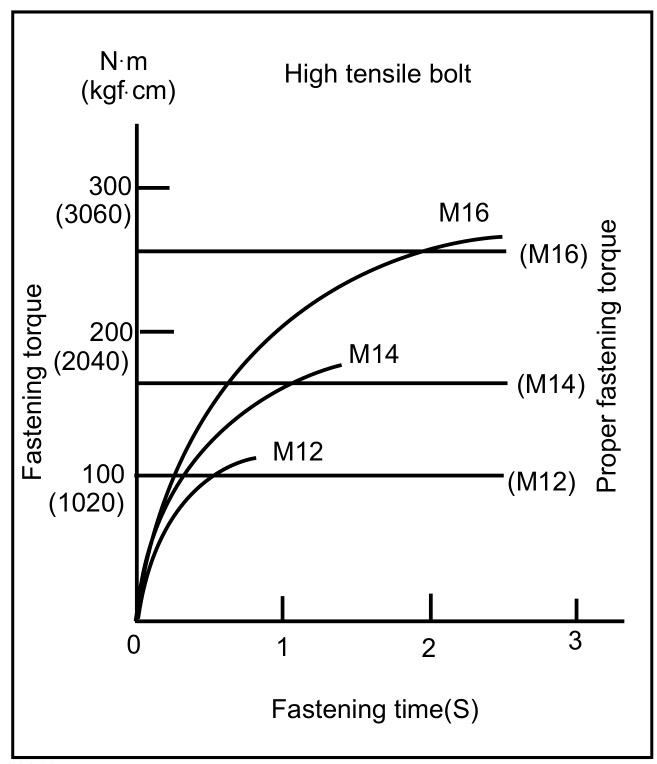makita BTW450 Cordless Impact Wrench Instruction Manual




Explanation of general view
1-1. Red part
1-2. Button
1-3. Battery cartridge
2-1. Switch trigger
3-1. Lamp
3-2. Lamp switch
4-1. Socket
4-2. Anvil
5-1. Socket
5-2. O-ring
5-3. Pin
6-1. Groove
6-2. Screw
6-3. Hook
8-1. Limit mark
9-1. Brush holder cap
9-2. Screwdriver
SPECIFICATIONS

- Due to our continuing programme of research and development, the specifications herein are subject to change without notice.
- Specifications and battery cartridge may differ from country to country.
- Weight, with battery cartridge, according to EPTA-Procedure 01/2003
Intended use
The tool is intended for fastening bolts and nuts.
Noise
The typical A-weighted noise level determined according to EN60745:
Sound pressure level (LpA) : 94 dB(A)
Sound power level (LWA) : 105 dB(A)
Uncertainty (K) : 3 dB(A)
Wear ear protection
Vibration
The vibration total value (tri-axial vector sum) determined according to EN60745:
Work mode : impact tightening of fasteners of the maximum capacity of the tool Vibration emission (ah) : 19 m/s2 Uncertainty (K) : 1.5 m/s2
For European countries only EC Declaration of Conformity We Makita Corporation as the responsible manufacturer declare that the following Makita machine(s):
Designation of Machine:
Cordless Impact Wrench
Model No./ Type: BTW450
are of series production and
Conforms to the following European Directives:
98/37/EC until 28th December 2009 and then with
2006/42/EC from 29th December 2009
And are manufactured in accordance with the following standards or standardised documents:
The technical documentation is kept by our authorised representative in Europe who is:
Makita International Europe Ltd, Michigan, Drive, Tongwell, Milton Keynes, MK15 8JD, England
30th January 2009
![]()
Tomoyasu Kato
Director
Makita Corporation
3-11-8, Sumiyoshi-cho,
Anjo, Aichi, JAPAN
CORDLESS IMPACT WRENCH SAFETY WARNINGS
- Hold power tool by insulated gripping surfaces, when performing an operation where the fastener may contact hidden wiring.
Fasteners contacting a “live” wire may make exposed metal parts of the power tool “live” and could give the operator an electric shock. - Wear ear protectors.
- Check the socket carefully for wear, cracks or damage before installation.
- Hold the tool firmly.
- Always be sure you have a firm footing.
Be sure no one is below when using the tool in high locations. - The proper fastening torque may differ depending upon the kind or size of the bolt.
Check the torque with a torque wrench.
SAVE THESE INSTRUCTIONS.
![]() WARNING:
WARNING:
DO NOT let comfort or familiarity with product (gained from repeated use) replace strict adherence to safety rules for the subject product. MISUSE or failure to follow the safety rules stated in this instruction manual may cause serious personal injury.
IMPORTANT SAFETY INSTRUCTIONS
FOR BATTERY CARTRIDGE
- Before using battery cartridge, read all instructions and cautionary markings on (1) battery charger, (2) battery, and (3) product using battery.
- Do not disassemble battery cartridge.
- If operating time has become excessively shorter, stop operating immediately. It may result in a risk of overheating, possible burns and even an explosion.
- If electrolyte gets into your eyes, rinse them out with clear water and seek medical attention right away. It may result in loss of your eyesight.
- Do not short the battery cartridge:
(1) Do not touch the terminals with any conductive material.
(2) Avoid storing battery cartridge in a container with other metal objects such as nails, coins, etc.
(3) Do not expose battery cartridge to water or rain.
A battery short can cause a large current flow, overheating, possible burns and even a breakdown. - Do not store the tool and battery cartridge in locations where the temperature may reach or exceed 50 ゚ C (122 ゚ F).
- Do not incinerate the battery cartridge even if it is severely damaged or is completely worn out. The battery cartridge can explode in a fire.
- Be careful not to drop or strike battery.
- Do not use dropped or struck battery.
SAVE THESE INSTRUCTIONS.
Tips for maintaining maximum battery life
- Charge the battery cartridge before completely discharged.
Always stop tool operation and charge the battery cartridge when you notice less tool power. - Never recharge a fully charged battery cartridge.
Overcharging shortens the battery service life. - Charge the battery cartridge with room temperature at 10 ゚ C – 40 ゚ C (50 ゚ F – 104 ゚ F).
Let a hot battery cartridge cool down before charging it.
FUNCTIONAL DESCRIPTION
![]() CAUTION:
CAUTION:
- Always be sure that the tool is switched off and the battery cartridge is removed before adjusting or checking function on the tool.
Installing or removing battery cartridge
Fig.1
- Always switch off the tool before installation or removal of the battery cartridge.
- To remove the battery cartridge, withdraw it from the tool while sliding the button on the front of the cartridge.
- To insert the battery cartridge, align the tongue on the battery cartridge with the groove in the housing and slip it into place. Always insert it all the way until it locks in place with a little click. If you can see the red part on the upper side of the button, it is not locked completely. Insert it fully until the red part cannot be seen. If not, it may accidentally fall out of the tool, causing injury to you or someone around you.
- Do not use force when inserting the battery cartridge. If the cartridge does not slide in easily, it is not being inserted correctly.
Switch action
Fig.2
![]() CAUTION:
CAUTION:
- Before inserting the battery cartridge into the tool, always check to see that the switch trigger actuates properly and returns to the “OFF” position when released.
- Change the direction of rotation only when the tool comes to a complete stop. Changing it before the tool stops may damage the tool.
The switch is reversible, providing either clockwise or counterclockwise rotation. To start the tool, simply pull the lower part (A) of the switch trigger for clockwise or the upper part (B) for counterclockwise. Release the switch trigger to stop.
Lighting up the front lamp
Fig.3
![]() CAUTION:
CAUTION:
- Do not look in the light or see the source of light directly.
Push the upper position of the lamp switch for turning on the light and the lower position for off.
NOTE:
- Use a dry cloth to wipe the dirt off the lens of lamp. Be careful not to scratch the lens of lamp, or it may lower the illumination.
- The light is provided with anti excessive discharge circuit. When the lamp does not light up even after the light switch is turned on, there is likely to be battery power drop. Try to charge the battery cartridge.
- Keep the lamp switch in “off” position while not in need of the light.
ASSEMBLY
![]() CAUTION:
CAUTION:
- Always be sure that the tool is switched off and the battery cartridge is removed before carrying out any work on the tool.
Selecting correct socket
Always use the correct size socket for bolts and nuts. An incorrect size socket will result in inaccurate and inconsistent fastening torque and/or damage to the bolt or nut.
Installing or removing socket
Fig.4
- For socket without O-ring and pin
To install the socket, push it onto the anvil of the tool until it locks into place.
To remove the socket, simply pull it off. - For socket with O-ring and pin
Fig.5
Move the O-ring out of the groove in the socket and remove the pin from the socket. Fit the socket onto the anvil of the tool so that the hole in the socket is aligned with the hole in the anvil. Insert the pin through the hole in the socket and anvil.
Then return the O-ring to the original position in the socket groove to retain the pin. To remove the socket, follow the installation procedures in reverse.
Align the hole in the side of the socket with the detent pin on the anvil and push it onto the anvil of the tool until it locks into place. Tap it lightly if required.
To remove the socket, simply pull it off.
Hook
![]() CAUTION:
CAUTION:
After installing the hook, make sure that it is screwed firmly.
Fig.6
The hook is convenient for temporarily hanging the tool.
This can be installed on either side of the tool.
To install the hook, insert it into a groove in the tool housing on either side and then secure it with a screw.
To remove, loosen the screw and then take it out.
OPERATION
![]() CAUTION:
CAUTION:
- Always insert the battery cartridge all the way until it locks in place. If you can see the red part on the upper side of the button, it is not locked completely.
Insert it fully until the red part cannot be seen. If not, it may accidentally fall out of the tool, causing injury to you or someone around you.
Hold the tool firmly and place the socket over the bolt or nut. Turn the tool on and fasten for the proper fastening time.
Fig.7
The proper fastening torque may differ depending upon the kind or size of the bolt, the material of the workpiece to be fastened, etc. The relation between fastening torque and fastening time is shown in the figures.


NOTE:
- Hold the tool pointed straight at the bolt or nut.
- Excessive fastening torque may damage the bolt/nut or socket. Before starting your job, always perform a test operation to determine the proper fastening time for your bolt or nut.
- If the tool is operated continuously until the battery cartridge has discharged, allow the tool to rest for 15 minutes before proceeding with a fresh battery cartridge.
The fastening torque is affected by a wide variety of factors including the following. After fastening, always check the torque with a torque wrench.
- When the battery cartridge is discharged almost completely, voltage will drop and the fastening torque will be reduced.
- Socket
• Failure to use the correct size socket will cause a reduction in the fastening torque.
• A worn socket (wear on the hex end or square end) will cause a reduction in the fastening torque. - Bolt
• Even though the torque coefficient and the class of bolt are the same, the proper fastening torque will differ according to the diameter of bolt.
• Even though the diameters of bolts are the same, the proper fastening torque will differ according to the torque coefficient, the class of bolt and the bolt length. - The use of the universal joint or the extension bar somewhat reduces the fastening force of the impact wrench. Compensate by fastening for a longer period of time.
- The manner of holding the tool or the material of driving position to be fastened will affect the torque.
- Operating the tool at low speed will cause a reduction in the fastening torque.
MAINTENANCE
![]() CAUTION:
CAUTION:
- Always be sure that the tool is switched off and the battery cartridge is removed before attempting to perform inspection or maintenance.
Replacing carbon brushes
Fig.8
Remove and check the carbon brushes regularly.
Replace when they wear down to the limit mark. Keep the carbon brushes clean and free to slip in the holders.
Both carbon brushes should be replaced at the same time. Use only identical carbon brushes.
Use a screwdriver to remove the brush holder caps.
Take out the worn carbon brushes, insert the new ones and secure the brush holder caps.
Fig.9
To maintain product SAFETY and RELIABILITY, repairs, any other maintenance or adjustment should be performed by Makita Authorized Service Centers, always using Makita replacement parts.
ACCESSORIES
![]() CAUTION:
CAUTION:
- These accessories or attachments are recommended for use with your Makita tool specified in this manual. The use of any other accessories or attachments might present a risk of injury to persons. Only use accessory or attachment for its stated purpose.
If you need any assistance for more details regarding these accessories, ask your local Makita Service Center.
- Sockets
- Extension bar
- Universal joint
- Bit adapter
- Makita genuine battery and charger


Makita Corporation Anjo, Aichi, Japan
884689A985

